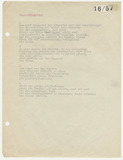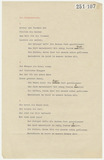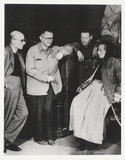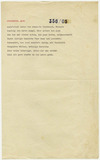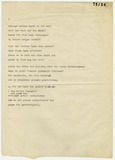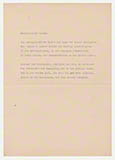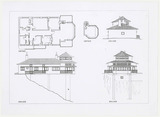Bertolt Brecht: Hollywood Elegies, typescript (1942)
Brecht writes songs about the dream factoryThe writer Bertolt Brecht saw life in Hollywood as one dominated by consumer goods and money. He had never experienced capitalism, which he fought against in Germany, in this form before.
Bertolt Brecht: Kaelbermarsch [March of the Calves], typescript (1943)
The lyricist Bertolt Brecht wrote the satirical song Kälbermarsch [March of the Calves] in September 1933, during his French exile. Later, Brecht incorporated it into his play Schweyk im Zweiten Weltkrieg [Schweyk in the Second World War], which he wrote between 1941 and 1944.
Bertolt Brecht: Mutter Courage und ihre Kinder
First rehearsals after returning from exile (1948)Erich Engel and Bertolt Brecht co-directed Brecht's drama Mother Courage and Her Children from November 1948 to January 1949 in Berlin. Helene Weigel took the lead role.
Bertolt Brecht: Svendborg, typescript (1938)
This poem comes from the collection, The Svenborg Poems, by writer Bertolt Brecht, which was published in Copenhagen in June 1939 under the title Poems in Exile. Besides observations concerning the political situation in Germany following the Nazi seizure of power, there are repeated references to his life on the run in Denmark, to the landscape and the house “under the Danish thatched roof”, in which he lived from 1933 to 1939 and which became a meeting place for many of his friends.
Bertolt Brecht: Thoughts About the Duration of Exile, typescript (1937)
The writer Bertolt Brecht wrote the poem Thoughts About the Duration of Exile in 1937 in the Danish town of Svendborg. Brecht by no means chose this place of exile by chance.
Bertolt Brecht: Work diary, 1938-1942 (1973)
The writer Bertolt Brecht was a tireless diarist. In addition to his private diaries, he also kept a work diary, which his wife Helene Weigel later designated his Arbeitsjournal [work diary].
Bodo Uhse: Die erste Schlacht, camouflage publication (1938)
Bodo Uhse’s report about the battalion that was named after the German communist Edgar André who was executed in 1936, which fought in the Spanish Civil War in the 9th and later on in the 11th International Brigade, was released in 1938 as a book published by the Strasbourg publisher Editions Prométhée. Brought to Germany and disseminated there, this literary chronicle of the events could only be released in the form of a camouflage publication.
Bodo Uhse: Lieutenant Bertram, book cover (1944)
In 1944 the New York publishers Simon & Schuster released the American edition of Bodo Uhse's novel Leutnant Bertram under the title Lieutenant Bertram. A novel of the Nazi Luftwaffe, translated by Catherine Hutter.
Bodo Uhse: Mexikanischer Garten, manuscript
What surprised the German writers Bodo Uhse, Egon Erwin Kisch or Anna Seghers (who had emigrated to Mexico in 1940) about the country's landscape was its otherness. Everything was subject to constant change, each volcanic eruption could alter the profile again.
Bruno Taut: Construction plans for his residence in Istanbul, 1937
For the two years preceding his sudden death at Christmas 1938, architect Bruno Taut was in exile in Turkey. He was responding to an offer to take up a position as professor of architecture at the University of Istanbul, an offer which he owed above all to an old German associate: the former Berlin town planner Martin Wagner, who had executed a number of major projects with Taut, and had been in Turkey since 1935 working as an urban development advisor to the Atatürk government.
